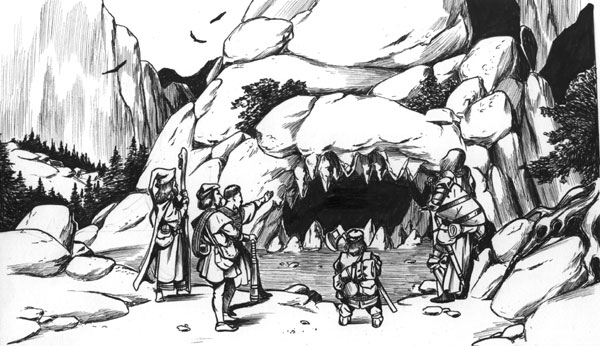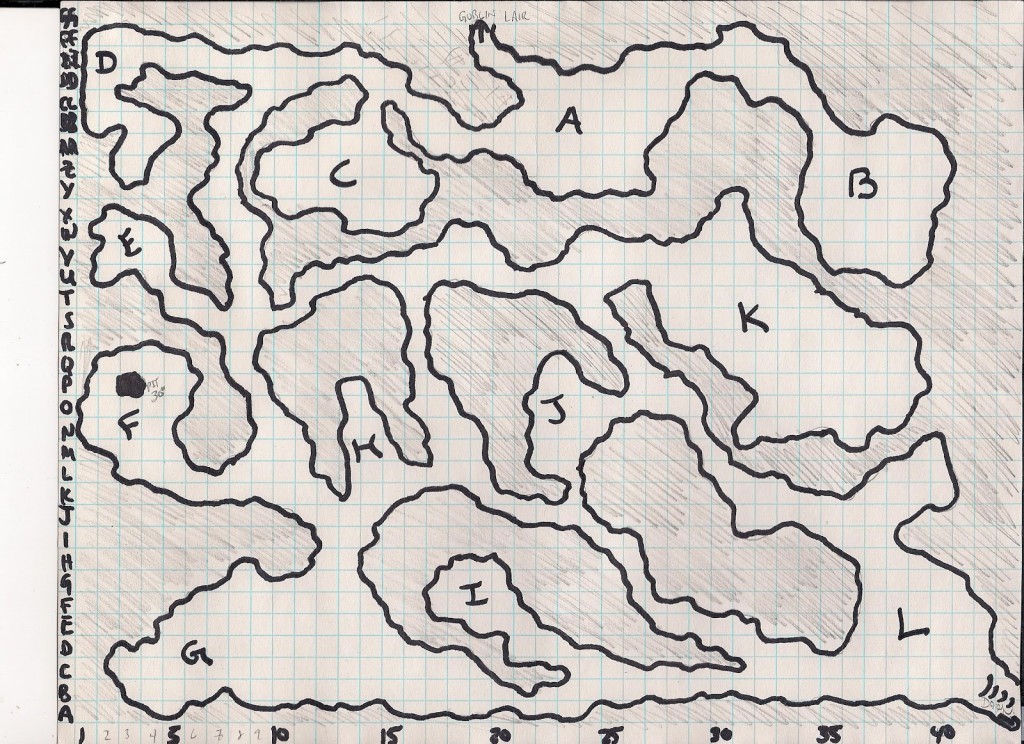One bit from Katie Hafner and Matthew Lyon’s Where Wizards Stay Up Late I found particularly interesting was a section of the chapter on E-Mail titled “Adventure and Quasar: The Open Net and Free Speech.” It featured Will Crowther, who was one of my favorite characters from this history of the internet. Earlier in the book he’s described as a brilliant computer programmer who had some eccentric working habits:
Crowther was quiet, easy to work with, and when it came to writing code, he was downright inspiring. He was also [Severio] Ornstein’s good friend and rock-climbing companion. Crowther seemed to concentrate best while hanging from door frames by his fingertips, doing chin-ups. And he was known for his mathematical doodling. While others passed the time at lengthy meetings by drawing squiggles and curlicues, Crowther filled his page with a thicket of differential equations. (98)*
And once he was done “hanging” around the office focusing his ideas, he would sit down and code for intensive intervals What’s not to love about Crowther? His code was described as “the leanest anyone who had worked with him had ever seen.” He worked alongside Dave Walden programming the packet processing for ARPANET. In 150 lines of code they had figured out the kernel that would launch the internet (100). I love this stuff, so already Crowther seemed pretty awesome to me. But when you marry that to the fact that in 1975/76, while going through a divorce, he used his recent passion for Dungeons and Dragons to program an interactive fiction game called “Colossal Cave Adventure” to connect with his young kids sublimates him to another level 😉
Crowther was an ardent cave explorere, and his wife Pat had achieved renown among cavers for having been part of a small group that discovered the first known link beteen the Mommoth and Flint Ridge caves in Kentucky….Crowther was the cartographer for the Cave Research Foundation. he used his off-hours to plot intricate subterranean maps on a BBN computer. In early 1976 Will and Pat divorced. Looking for something he could do with his two small children , he hit upon an idea that united Will the Programmer with Willie the imaginary theif: a simplified, computer version of Dungeons and Dragons called Adventure. (206)
This story seems like the convergence point of modern nerd culture in so many ways. Programming, Dungeons and Dragons, and spelunking. According to Crowther he wrote the game over the course of a few weekends, played it a bit with his kids and colleagues and then left it paritally finished as his spirit was increasingly tapped by the divorce. Nonetheless, others found it and distibuted it and the game started filtering through the networked community. Crowther was approached by Don Woods, a Stanford graduate student in Articial Intelligence, and asked if he could refine the game to which Crowther was more than happy agree.
When Woods had finished his contributions to Adventure, “he created a guest account on the computer at the Stanford AI Lab to let people play, and swarms of people logged in. Adventuture spread like hula hoops, as people sent the program to one another over the network” (207). What I liked about this whole story was how the authors tie the passion people had for this game, which inspired a whole generation of games like the Atari 2600 Adventure as well as the interactive fiction game Zork, to the features of an open network . The open collaboration and free distribution of Adventure captured an ethos that helped this game flourish, and it was made possible because of the open network that was the internet:
Adventure demonstrated the appeal of an open networking culture. And the emphasis on openness grew with time. There were few closed doors on the network, and a free-spirit prevailed in people’s attitudes about who could come and go through them, and for what purposes….ARPANET was official federal government property, but network mail was being used for all manner of daily conversation. (208)
It’s not surprising that E-Mail was the killer app of the early interet because it provided a sense of community in early network culture. It’s also not surprising that the passion driving some of the best demonstrations of open sharing in the early network came in the form of a computer game—an immersive experience based on a port of a popular role playing game that people were pasionate about. It’s funny how much this history paralles so much of how internet culture still operates.
For a more detailed look the cultural history of Adventure take a look at Dennis Jerz’s article in the Digital Humanities Quarterly “Somewhere Nearby is Colossal Cave: Examining Will Crowther’s Original ‘Adventure’ in Code and in Kentucky.” I think this topic would make an interesting investigation for a group of students in The Internet Course. I can see it now, “the cultural history off network gaming!” I’m just full of ideas on the bava this weekend for all the work the students could do 🙂
* All citations are from the 1996 hardback Where Wizards Stay Up Late printed by Simon & Schuster.




I really enjoy Colossal Cave Adventure. So much so that I had my electronic literature students play it a couple of weeks ago. It’s an interesting experience in defamiliarizing gameplay for many of them. As a game, it’s not “hard” in ways that they expect, but it’s hard to get used to the interface, to the types of puzzles and expectations of story telling that it presents. Few can get very far in it, even experienced gamers — and those gamers are the ones who sometimes just blame the game for being so terrible. It’s a teachable moment in the history of technology but also the history of lowering expectations for ease in game play.
I wasn’t familiar with this book you’re quoting from, but its portrayal of Crowther is really interesting, especially given his notable absence from the recent documentary Get Lamp wherein he’s described as “the J.D. Salinger” of text adventures. Seems like a cool guy, but he’s declined to be involved or interviewed.
Jerz article is excellent as well, though you’ll notice he corrects the record on at least one point from your Hafney quote re: Don Woods relationship to the game. Jerz finds the original FORTRAN source code and reveals that Crowther’s version was already basically complete, and that Woods found it online and just tweaked it a bit.
I don’t know if you’re getting into this at all with this class, but there’s a healthy community of people still making these sorts of games. There’s a nice, web-based platform at PlayFic.com for writing and sharing one’s games.
Also worth mentionin, Twine is pretty great.
Oh yeah, and I had a group of students a few years ago in my video game canon FSEM that did their project on Colossal Cave Adventure. It should be on our class website; I’ll see if I can find that.
I was hoping you would rcomment here because I knwo this is your baliwick. It’s been really eye-opening, and somehow organic, to come to many of these topics via a popular history of the creation of the internet. Gaming will play a larger part of the class in weeks 9 and 10 when we get to the culture of the internet. As I mentioned, I’m hoping some of them will pursue this line of thinking given how much gaming has shaped today’s culture. I am thinking of CPSC 110 as an integral part of the Digital Studies minor. Like Digital Studies 101, this could be a good basckground course on the internet specifically, and might make a solid lower-level part of the curriculum like DS106.
I have to say teaching this course has really helped me fill in a bunch of gaps in my internet knowledge, and it’s really fun. I dpownloaded Adventure this morning, and I plan on playing it tomorrow. I originally thought they were talking about the 1979 Atari version in the book, and I was like, “wow, that’s really early.” I’m an idiot! 🙂
It would be cool to do the history of interactive fiction as an interactive fiction course. I remmeber there was a student of yours that had caught the IF bug, and did there final project for ds106 as a IF tour of downtown Fredericksburg, it was awesome.
Also, thinks for the link to the Get Lamp documentary, I feel myself getting pulled deeper and deeper into the maze 😉
Thanks for the comment and link to that student exhibit, this will be incorproated into THE INTERNET COURSE.
I’ve been meaning to talk to you about this Internet course and its future. Depending on its frequency and CPSC’s commitment to it, I wonder if it would make sense to have it along with DGST 101, CPSC 106 as possible intro courses for the minor. Like we could make the requirement “take at least one of these three”. There are probably some downsides to that approach, but on the pro side that would give students more options. Of course, we’d need CPSC deparment support going forward.
Here’s that student project I was thinking of: http://vgc.zachwhalen.net/exhibit/Colossal%20Cave%20Adventure
Sharing http://en.wikipedia.org/wiki/Robert_Tappan_Morris as he has a similar history – his life almost sums the internet up.
The wiki article misses out the time he spent building MUDs. I miss port numbers really, where you could find different MUDs on the same server and just hang out and build stuff.
I spent a long time here at Uni http://mudstats.com/World/TheChattingZone(TCZ) – you could build rooms. Someone built the sewers from It and you could walk round with people and Pennywise would chase. Can see how spaces like this relate to Domain of one’s own, but perhaps with a hugely social layer as the base. So you had your own space, but you built stuff with it to explicitly share.
Pat,
What’s awesome about Morris is he is also responsible for the first real networked worm/virus, which made his name MUD for some 🙂 [Very bad, I know, but I couldn’t resist.] #geek
I have a book about it – the best thing is, when the internet started to grind to a halt, one sys admin knew only one person had the skills to produce what he was seeing, so he called Morris up and asked how to fix it 🙂
Pingback: Bad Day on the Midway | bavatuesdays
I second Zach on watching Get Lamp. It’s very instructive about the early history of video games and the history of text based adventures.
If the map shown above is using popular assumptions of graph paper scale those rooms are massive. 10 foot by 10 foot is what most maps are scaled at.
If you are looking at gaming culture on the internet I would advise you look into pen and paper gaming and how it is played online. Since summer 2011 old school d&d and its simulacrum have been played on g+ hangouts. There are games taking place every day of the week and sometimes many during the same day. Most allow people to take their PCs to new games. Which can provide for interesting encounters. The agreement to allow players to enter different games is called FLAILSNAILS and the concept of playing games online in this manner is called Constantcon
These are the founding documents
http://jrients.blogspot.com/2011/08/flailsnails-conventions.html
http://dndwithpornstars.blogspot.com/2011/07/constantcon-2011-starts-now.html
There also is a female ran online gaming con called Contessa. It’s happened for the last 2 years. All games and panels are run by women.
http://contessaonline.com/